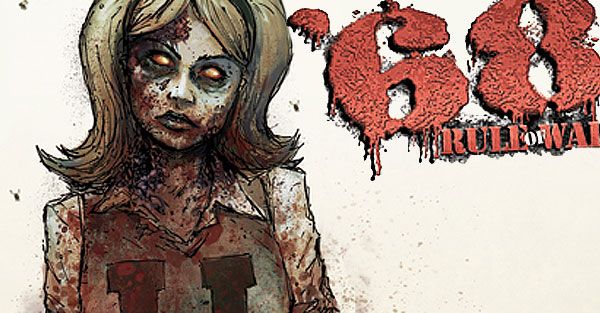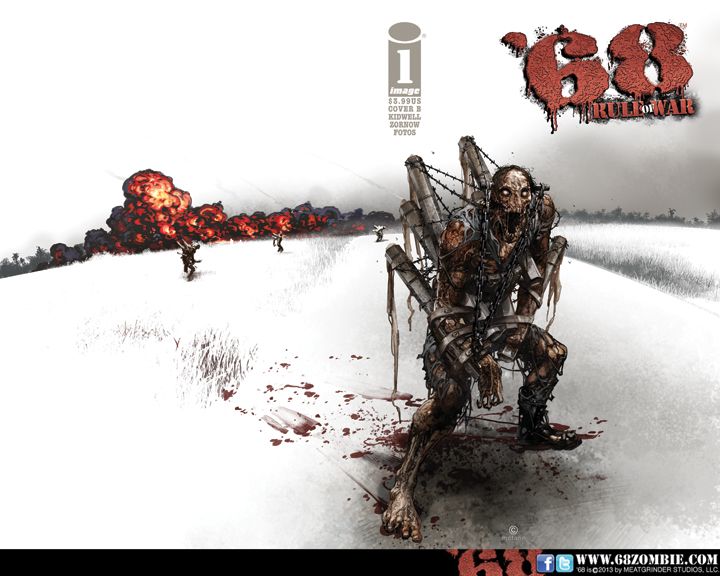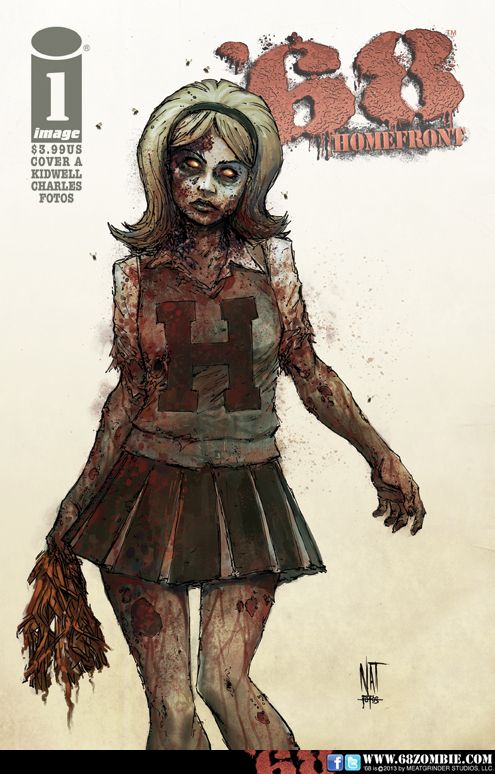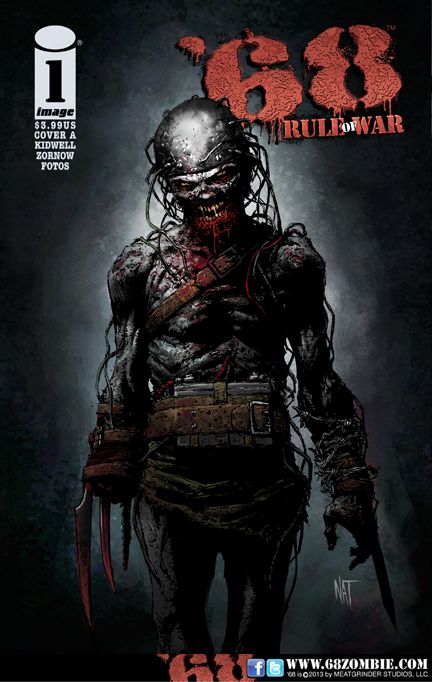In 1968, George Romero released his first feature-length film: "Night of the Living Dead." A classic zombie movie that sparked a horror sub-genre, Romero's movie wasn't just about hordes of shuffling ghouls ripping apart hapless victims, but a reflection of unexpressed anger and silent tensions ripping apart society in the 1960s. Although it was set in a quaint American town, the film could be viewed as warped reflection of the atrocities of the Vietnam War -- carnage, violence, isolation and disillusionment. "Night of the Living Dead" had a powerful reach, inspiring film makers and writers to this day, including the team behind Image Comics' "'68" who pose the question: What would've happened if the zombie outbreak in the film was real and spread into war operations?

Mark Kidwell, Jay Fotos and < href="https://www.comicbookresources.com/tag/jeff+zornow">Jeff Zornow have been creating horrifying intersections of the undead and the Vietnam War since 2006 in the pages of miniseries and one-shots, following survivors in the States and overseas. Their latest four-issue series, "'68: Rule of War," launches on April 2 and follows a CIA Special Agent tracking a demented neurosurgeon through Cambodia that will make readers wonder who the more terrifying monster is: the zombies or humans?
Kidwell and Zornow spilled their guts to CBR News about the miniseries, including their personal connections to war, how they've been influenced by horror films and their plans to survive a zombie outbreak, which are Shark Tested, Mark Kidwell Approved.
CBR News: Your story features several terrifying elements -- war, medical experimentation, zombies, and the darkness inside of people. I'd like to start with the first -- do any of you have a connection to the Vietnam War? What inspired you set your story during this time period?
Mark Kidwell: My dad was a merchant marine during 'Nam. He didn't see combat, of course; his ship was tasked with delivering munitions to Saigon from the U.S., but he did relate several stories to me, one of which found it's way into an issue of "'68: Scars." (It's the scene with the zombie whose guts are filled with Mekong Delta river snakes.)
The main inspiration for the entirety of the '68 concept came from the original, first-ever zombie movie, "Night of the Living Dead." That film came out in 1968, and for some reason, no one had ever drawn a connection to the rise of the living dead in that film to what might have been going down in the rest of the world. What was going on, for the most part, was Vietnam. Imagine that war, with all the unburied dead. Imagine being in the middle of all that real-life horror when the guys you just shot yesterday are shambling toward you again today, only this time they want to eat you. Instant horror overload.
Jeff Zornow: I was born just after the war, and I'm forgetting what my step-dad was doing at the time, so unless I can get him on the phone later today I'll skip that part, but Vietnam is one of the most perfect settings for a horror story like this because of what it represents to our history as Americans.
The Vietnam War and the late '60s were easily the most tumultuous times in America's history that many who were a part of it are still around and can recall. Everything went through drastic changes, with Americans distrust for their own government, perceptions of our own humanity, perceptions of what society should be, etc. It's no wonder that this also led to the greatest horror boom in pop culture history, in that horror movies were no longer trying to take you for a thrill ride of spooky escapism and then let you off with a feeling of "that was great! Let's do it again!" -- NOW horror movies were literally trying to drive you out of your mind. And a great many of them succeeded, and still do to this day.
Romero's "Night of the Living Dead" was hugely influential in the history of horror -- tell me about the first time you saw the film. Did it make an immediate impression on you?
Kidwell: Y'know, I think the best thing about "Night of the Living Dead" for me was that I didn't see it for a long, long time. I was a rabid fan of horror and horror magazines as a kid, but grew up in a very, very small town in a rural area, so we didn't get films like that in our theater, especially retro stuff from the 1960's, and I never, ever saw it on TV back then. So, as a result, I had to imagine what happened onscreen, with my only clues being black and white stills from the mags. I finally saw the whole movie when I was in my late teens, and by that time, I'd seen a lot, stuff like "Dawn of the Dead," "Evil Dead," "Texas Chainsaw Massacre," before actually seeing NOTLD. I honestly expected to be let down a little, since it was black and white and I knew much of the gore was only insinuated. I'm happy to report that the movie kicked my ass. Despite all the Technicolor spew and hack I'd already seen, NOTLD set me on edge and with that "documentary" feel and rough grain, spooked me good and burned itself into my horror top ten. There's a reason that film stuck around.
Zornow: Oh, yeah -- I first saw NOTLD when I was a kid on Halloween, long after trick or treating was over for the night. I had heard of the movie before, but had not seen it; I was probably 11. It was the first time I ever saw a movie with such a dismal and horrifically grim ending. Oh, yeah -- that left an impression on me. How can that ending not mess with anyone when they see it for the first time?
Zombies have been huge in pop culture for years now, and we've had the pleasure of seeing so many different takes on the mythology. What is it about zombies that keeps them perennially scary? And what type of zombies will we see in the issues to come in your series?
Kidwell: I've been asked that question a billion times now and rather than give you my stock answer, I'm goin' out on a limb here and postulating a newer theory of mine. Zombies are cancer. There it is -- it's out.
It seems to me that one of the biggest fears we have as modern human beings is the fear of some sort of disastrous medical condition, ticking away inside us, "eating" us in this case and we cannot stop it. Focus on that -- we "cannot" kill it while it works to destroy the host. After all these years, we still can't cure many forms of cancer (unfortunately) and it changes us, depresses us and scares us. Even the initial diagnosis threatens to drive us mad, "eat" us alive. Sound familiar? Zombies are us. Or they used to be us before -- before what? Before a virus or dregs of said virus are transmitted to us via a savage bite or similar invasion to our bloodstreams. And now, we're sick. We're "infected," we've got the disease and there ain't no cure baby -- unless you count getting shot in the temple.
So that's my theory, now: You get bitten, you've got "it." You can't get rid of it, modern medicine is stymied by it and "it" is gonna get you. Gonna eat you alive. Zombies are us, infected by horror and driven, through some perverse, unfathomable urge to attack and consume healthy tissue, spreading the contagion and making everybody else suffer the same. Zombies=hungry tumors on two legs, the disease made flesh.
Zornow: Personally, I really have never found zombies to really be that scary, even when I was a kid. A deformed masked maniac in the woods with a sharp bladed weapon? Yeah, that scares me, but zombies have always fallen into the "monster" category, and monsters aren't scary to me. They are my brethren. Now I'm not saying I relate to the zombies in zombie movies or stories, but it's more like if one were a dog lover. They'll probably watch dog movies for the dogs and not the human characters as much. When zombies pull apart human beings and eat them, its sorta as enjoyable as watching dogs doing adorable things.
Also, zombies, as far as monsters go, they are the easiest for people to suspend their disbelief for, that has always been the case which is partially what I think Romero always meant when he referred to them as the "Blue Collar Monster" zombies are easy to put to work, they work well, and for cheap. Zombies thrill and entertain, and they look great doing it.
However, since zombies are allll over the place in the popular culture right now, again, we are of course stepping up the game with -- FRANKEN-ZOMBIES! Being that we are all monster guys, combining Frankenstein-like elements into the zombie element is a nice shot in the arm, if you ask me! We are taking two of the most beloved monster visual cues and mad-scientisting them together. At least from the visual side, that's how I see them. Way more fun to draw than just walking wormfood.
Fans and casual readers who want more '68 information and background are invited to explore our website at www.68zombie.com or friend us on Facebook. We've just started an exclusive e-mail newsletter that provides members of the '68 ARMY with exclusive behind-the-scenes stuff, sneak peeks and tons of extras. Fans can sign up under the "Mail-Call" button on the site.
Have you decided what your survival plan is in case of some sort of zombie outbreak?
Kidwell: Chainmail, leather, duct tape and a machete'. Bite through that? I don't think so. (Sharks can't -- just sayin'.)
Zornow: Actually Mark, sharks can bite through chainmail atop a wetsuit, and the shark doesn't even have to be very big to do so. I'm talking average sized blue shark -- saw that on "National Geographic" when I was a kid.
Kidwell: Jeff -- zombies ain't sharks.
We already are in a zombie apocalypse, only the zombies aren't eating human flesh: they are absorbing whatever is in their smart phones. Most likely this won't ever really affect me, though if it does I'll just head over to Monster Island with Godzilla and the other monsters -- by the way, don't forget to also check out my artwork on IDW's "Godzilla: Rulers of the Earth" series where I provide covers and fill-in interior art!
Getting into one of the other elements, and the one that's the most personally scary for me -- the medical experimentation. What is the tone of this in your series? Is it coming from a place of developing super soldiers, is it more in line with early forays into transhumanism -- what is the objective of the experimentation?
Kidwell: Well -- not to give too much away before the series has its run -- we're not so much creating super-soldiers as we are living weapons. Think terrorists with mindless, rotting suicide bombers at their disposal. Find a way to control them, motivate them -- then load them up with C4, dynamite or grenades and point 'em at the enemy. Weld a steel plate to their heads so that famous headshot won't do its trick and you've got a nearly unstoppable automaton aimed wherever you want and your finger is on the trigger. It could alter the balance of a war. Also, as the story will reveal, this experimentation began prior to the rise of the dead, so the early "subjects" undergoing this process were -- alive. It's just easier with the dead -- they don't expire after hours of barbaric brain surgery.

Let's talk about Private Keun Yam -- he's leading a group of survivors, hopefully to safety. What kind of a person is he? And how is he coping with the madness around him?
Kidwell: I hope by now, faithful readers can see Yam as an adapter. He started out in the first story arc as a pretty sheepish loner, forced into that role by his own ethnicity and the nature of the enemy in Vietnam. Since then, he's turned a corner. He's not so willing to follow anymore. He's feeling that awakening urge to lead, to question the things his superiors and fellow soldiers suggest or ask of him. Much like actual war (and I can only guess at this experience, because I haven't lived it), Yam's situation is "growing him up," toughening him, forcing him away from his comfort zone with his parents in New York and stretching him, kicking and screaming, into a man. As far as coping with the madness, Yam is particularly insulated against it, owing to his former situation with his fellow soldiers. He's always been the outsider, the guy keeping his hate, fear and thoughts to himself. This allows him to tamp down the horror as the dead rise. He just transfers his ability to deal with adversity from the old situation to the next. Yam's a hard-ass and he's only getting tougher.
Zornow: Yam is interesting to draw as he currently has more expressional range than the others, however I am sorta falling in love with "Rule of War's" villain, Than Morneau. As a general rule I always love the villains more than the heroes; they are almost ALWAYS more interesting, as well as more fun to draw.
Always root for the heels!!!
Kidwell: Yeah -- good ol' doc Morneau -- props to H.G. Wells here -- you know what I mean, right?
What is Yam's team like?
Kidwell: A mixed bag, for sure. You've got the "tribe," Samson and Hickock -- Samson is a full-blooded Sioux Indian who decks himself out in war paint and Hickock, his buddy and all-around super pilot, follows his lead, painting himself the same way to humor his pal. Both are reliable, hardened vets and good with their guns as well as their wits. Nurse Alice Gleason (named for Audrey Meadows' character in "The Honeymooners" as well as Jackie Gleason, Meadows' co-star in that series) is a little on the damaged side. She was abused as a child and bears the scars from the experience. She's hardened herself over the years, thrown herself into her work and cares more for others than herself. There's electricity between she and young Yam though, and as a result, she's starting to "humanize" again. Finally, we've got Watson, Henry J. He's a young, inner-city black soldier who breaks out of the cliched mold in that he's bookish. He reads anything he can get his hands on. He's smart, opinionated and good at keeping himself alive.
Visually speaking, there are so many graphic elements in your series. What has been the most fun to draw? What was important for you to convey with the art?
Zornow: The most important thing to convey with the art is a clear story. Making sure what Mark wants to convey to the reader is communicated with the art, and visual storytelling. Everything else should fall into place after that. Though personally it was also important for me to bring a level of splatter you don't see a whole lot of these days. I'm not saying there aren't other gory books out there, but there aren't many. Since I myself revel in gore, I have no problem pulling out all the stops and going over the top with some gore-sploitation.
Plus, that gore element, whether you like it or not, will also always get fans to talk and make exclamations. And we like that.
Horror comics have always been fun for me to draw. It's obviously my favorite genre, and I've been making a bloody mark in it for several years now. One of the most fun and challenging aspects of drawing horror has been drawing people showcasing the entire rainbow of emotions, from one extreme to the other. As well as pacing the visual elements with composition and design to make the story slow down or grab your throat when it needs to.
What is in store for the '68 series? Where else are you interested in taking it?
Kidwell: There's really no end to the potential for storytelling in the '68 universe. After all, we've got the whole world to play around in. The calendar stopped losing sheets on February 14, 1968, but the globe keeps spinning. Days and nights tick by, and the only difference is that it's 1968 forever. No more new music, books, movies -- no TV, nightly news or mail service. So the stories keep coming and the drama just keeps ramping up.
As far as where we're taking it -- in the near future, we're going back home, back to America with an all-new four-issue series entitled "'68: Homefront." It's a cool arc, featuring two back-to-back storylines that run two issues each. The first is called, "Peece and Love" and gives us a peek into the heartland of the United States as dead things start to rise from bloody back road pavement and mortuary embalming tables. Next, the second installment, entitled, "Dodgers" will show you what happens when you burn your draft card and head for Canada to escape the horrors of Vietnam. Turns out, there's plenty of horror up north too. Think rotted Mounties and lots of red snow and you're on the right track. After that -- who knows? It's '68 forever, and this virus is everywhere!




